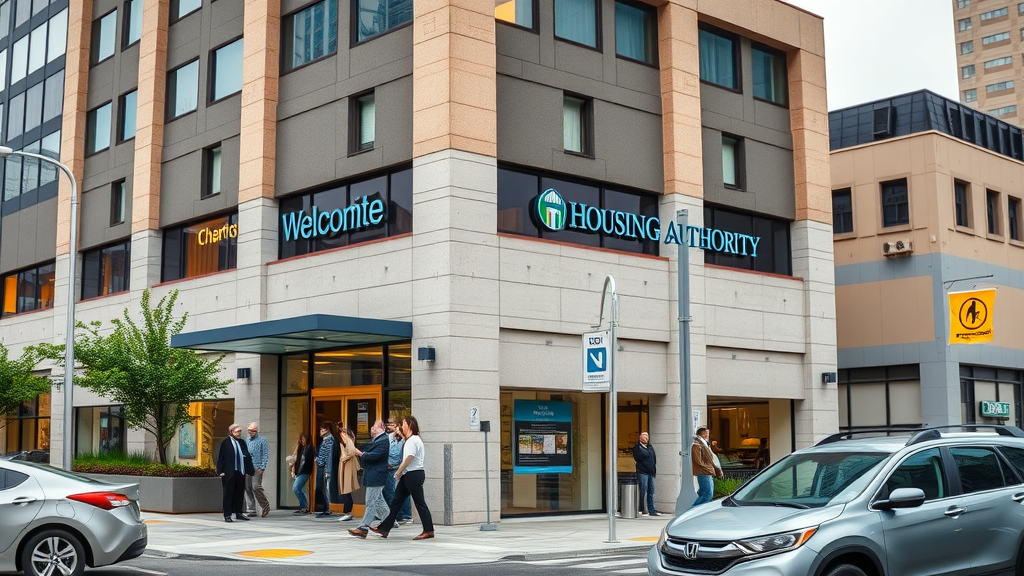Did you know over a dozen Fortune 500 company headquarters thrive within Charlotte’s financial district—more than anywhere else in North Carolina? Living here puts you at the epicenter of opportunity, vibrant city life, and luxury living. If you’re searching for a stunning balance of work, community, and play, financial district housing Charlotte is the best destination to call home.
Ready to explore modern comfort, unbeatable location, and investment-worthy living? Here’s everything you need to know to find your next spacious floor plan in one of Charlotte’s most sought-after neighborhoods.
Discover Why Financial District Housing Charlotte is Revolutionizing Urban Living
Charlotte’s financial district housing is redefining what it means to live in an urban environment. With world-renowned institutions such as Bank of America at your doorstep and a skyline dotted with luxury and ready homes, this is where work-life balance truly comes alive. Living here grants you access to sleek, designer finishes and expansive amenity spaces all within a walkable, safe neighborhood.
Step outside your apartment and instantly tap into the pulse of uptown Charlotte . You’ll find yourself surrounded by vibrant nightlife, high-end restaurants, business centers, and cultural hotspots, all within minutes. The urban movement here caters to a spectrum of residents—from young professionals rising through corporate ranks to families desiring modern, urban comfort. Plus, with top-rated fitness center facilities and instant proximity to the light rail , living in this district is about more than location; it’s a lifestyle revolution filled with convenience and opportunity.

"Did you know Charlotte’s financial district is home to more Fortune 500 company headquarters than any other city in North Carolina? Living here means having the heartbeat of commerce and culture at your doorstep."
What You'll Gain by Choosing Financial District Housing Charlotte
- Immediate proximity to uptown Charlotte and major employers like Bank of America
- Access to luxury and affordable housing options such as Miller and York
- Unrivaled access to dining, entertainment, and transportation
- Walkability and urban convenience
- A vibrant neighborhood mix catering to professionals, families, and students

Prime Location: Financial District Housing Charlotte in Uptown Charlotte
Living in the heart of uptown Charlotte ensures that daily commutes become a thing of the past. The financial district is strategically positioned to offer you the shortest access routes to major business hubs, including Bank of America , as well as exceptional walk scores that make everything from dining to groceries instantly accessible. This ultra-connected location is further enriched by its integration into the city’s light rail network and proximity to all that uptown Charlotte has to offer.
You’re not just moving into a new home—you’re stepping into a thriving, walkable ecosystem filled with great location options, high-end retail, and lively community amenities. Whether you crave easy mornings with specialty coffee shops or need flexible access to EV charging and business center services, living here is about unlimited urban potential.
| Feature | Financial District | Other Charlotte Areas |
|---|---|---|
| Proximity to Business Hubs | Highest (1-5 min walk) | Medium-Long (10-20 min) |
| Average Rental Price | $1,500-$3,000 | $1,100-$2,100 |
| Access to Amenities | Premium | Standard |
| Walkability Score | 98 | 78 |
Spotlight on Living: Miller and York and Other Iconic Financial District Residences
In-Depth Features and Reviews: Miller and York
Miller and York stand as a shining example of luxury living in financial district housing Charlotte. These apartments boast modern interiors with stainless steel appliances , granite countertops, and spacious floor plans designed for both elegance and comfort. Smart layouts and designer finishes create an environment that’s inviting and refined, offering options suitable for everyone from single professionals to growing families. The flexibility of lease terms is an added bonus for those seeking adaptability, making Miller and York ideal for busy corporate commuters, remote workers, and purpose-driven residents.
- Modern interiors and luxury finishes
- Flexible lease terms for professionals
- Fitness facility, rooftop lounge, and co-working spaces
- Pet-friendly and secure community
Community amenities give residents priority access to co-working lounges, a fitness center, and controlled access security features. Pet lovers are welcome since pets allowed is the norm, making Miller and York a true home for all. Whether you’re after a restful rooftop escape with panoramic city views or need maintenance on site for total peace of mind, this distinctive address delivers.

Other Noteworthy Residences Near Bank of America Headquarters
- SkyHouse Uptown: Stunning skyline views and close to nightlife
- The VUE Charlotte: Resort-style amenities ideal for working professionals
- The Mint: Art-inspired design with an eco-friendly ethos
Each of these residences brings something unique to the table while offering the same trademark of location and modern comfort you expect in the financial district housing Charlotte market. Whether it’s dramatic skyline vistas at SkyHouse, a full suite of resort-level amenities at The VUE, or sustainable features at The Mint, every complex supports the urban professional lifestyle with convenient access to the city’s business epicenter and surrounding cultural attractions.
Financial District Housing Charlotte: Who’s It For?
- Young professionals seeking career growth near uptown Charlotte
- Families prioritizing safe, walkable, urban environments
- Remote workers and entrepreneurs looking for co-working lounges
- Students attending nearby universities or internships with Bank of America
This neighborhood is tailored for those who want to maximize their career opportunities while still enjoying a balanced, fulfilled lifestyle. If you want walkable access to business center employers or value unique, on-site amenities like fitness studios, co-working lounges, and vibrant social spaces, living in the financial district simply makes sense. With everything from affordable to luxury living options, mixed-use communities, and controlled access properties, there’s a housing type for every background—making it easy to find your ideal fit.

Investment Value: Why Financial District Housing Charlotte Retains Its Appeal
The appeal of financial district housing Charlotte extends well beyond location and amenities—it’s a proven investment. Consistently outperforming other neighborhoods in terms of property appreciation, homes here retain value thanks to the booming corporate landscape ( Bank of America , Wells Fargo, Truist) and the city’s commitment to continuous urban innovation. Whether purchasing as an owner or seeking a lucrative rental investment, properties in the heart of Charlotte offer sustainable real estate growth and high demand.
"The financial district in Charlotte consistently outperforms other neighborhoods in property value appreciation, thanks to booming corporate presence and continuous urban growth."
For investors and residents alike, this means financial district housing doesn’t just provide a home—it’s a stepping stone to building lasting wealth in one of the nation’s fastest-growing cities.
How Much Does It Cost to Live in a Financial District?
The average rent for a one-bedroom apartment in financial district housing Charlotte ranges from $1,500 to $3,000 per month depending on building age, amenities, and precise location. While these prices reflect a premium over the median for the broader neighborhood of Charlotte , residents consistently cite the trade-off for convenience, safety, and access to major employers like Bank of America as well worth it. Amenities such as unit washer and dryer, smart home technology, granite countertops, and in-building gyms push the value even higher.
If affordability is a concern, consider apartment shares, or explore smaller floor plans within newer buildings that retain the district’s sought-after location and design standards. The investment in this vibrant, walkable neighborhood pays dividends through time savings and quality of life.
How to Apply for Low Income Housing in Charlotte, NC
To apply for low income financial district housing Charlotte , first visit the Charlotte Housing Authority website to review the latest eligibility guidelines. Applicants must complete an online application and provide details regarding income, family size, and current housing situation. Documentation is required, and wait times can vary depending on need and local demand, but priority is given based on income and urgency.
Many subsidized housing options exist within or near the financial district, giving those who qualify a realistic path to urban, amenity-rich living in the city’s economic core. Persistence and early application are key, especially during high-demand periods.

Where is the Financial District in Charlotte?
Charlotte’s financial district sits at the beating heart of uptown Charlotte , bordered by E. Trade St., S. Tryon St., and W. 4th St. This prime location is easily recognized by its striking skyline featuring the Bank of America Corporate Center, Truist headquarters, and numerous residential towers. A stroll through these corridors offers a sense of the city’s economic engine with instant access to high-end restaurants, theaters, and the best of urban nightlife.
Whether seeking walkable commutes or proximity to business center resources, living in the financial district of Charlotte puts you where everything happens.
What is the Cheapest Area to Live in Charlotte, NC?
While financial district housing Charlotte is unrivaled in prestige and proximity, the city offers several more budget-conscious neighborhoods. East Charlotte , University City , and Charlotte’s west side are known for more affordable rental and home prices. These areas, though situated farther from uptown, often provide increased square footage and a different mix of amenity spaces, making them suitable for those ready to commute or in search of larger family housing types.
For some, the tradeoff is worth the extra minutes in transit, especially with reliable light rail options and easy access to suburban amenities. Yet, those weighing housing type, amenities, and lifestyle against cost should consider both immediate and long-term priorities before making a decision.
Video Tour: Explore Financial District Housing Charlotte (Uptown Focus)

Virtual and drone video tours offer an immersive look at both the iconic skyline and the pedestrian-friendly streetscapes that make living in the financial district of Charlotte so appealing. Whether you want a bird’s-eye view of Bank of America, glimpses of high-rise luxury living at Miller and York, or a sense of how the district lights up at night, there’s no substitute for a firsthand look—online or in person.
Be sure to view listings and schedule tours early, as the market moves fast and the best apartments are in high demand year-round.
Essential Tips When Choosing Financial District Housing Charlotte
- Research building history and resident reviews for Miller and York and surrounding complexes
- Check lease options for added flexibility
- Compare amenity packages to match your lifestyle
- Use cost-of-living calculators for budgeting
- Prioritize access to transportation and local services
Before signing your lease in financial district housing Charlotte , diligence matters. Investigate available floor plans and check if amenities like on-site EV charging , unit washer and dryer, and controlled access security systems align with your expectations of modern comfort. Analyzing resident feedback, lease flexibility, and walk scores will further ensure a smooth transition into Charlotte’s most exclusive neighborhood.
FAQs About Financial District Housing Charlotte
-
Can I find pet-friendly housing in the financial district Charlotte?
Yes, most complexes—including luxury residences like Miller and York—are pet-friendly. Expect on-site pet amenities and ample walkable green space. -
What security features are typical?
Controlled access, 24/7 security teams, surveillance cameras, and key-fob entry are standard, prioritizing resident safety. -
Are short-term leases common?
Many financial district properties offer flexible lease lengths, from 3-month options for interns and professionals to standard yearly leases. -
How far is uptown Charlotte nightlife from most residences?
Uptown nightlife, restaurants, and bars are just steps away. Most venues are within a 5–10 minute walk, or a brief ride on the light rail. -
What utilities are included in most rents?
Utilities vary by building but often include water, trash, and sometimes high-speed internet. Electric and optional upgrades (like EV charging) may be billed separately.
The Distinct Advantage of Living in Financial District Housing Charlotte
Choosing financial district housing Charlotte means immediate access to top employers, luxury amenities, and a neighborhood with enduring investment value. Secure your ideal home now—step into a thriving uptown community and experience everything Charlotte has to offer.
Sources
- https://www.cha-nc.org – Charlotte Housing Authority
- https://www.apartments.com/miller-and-york-charlotte-nc/ – Apartments.com: Miller and York
- https://www.charlottesgotalot.com/neighborhoods/uptown – Charlotte's Got A Lot: Uptown Charlotte
- https://www.bankofamerica.com – Bank of America
- https://www.trulia.com/nc/charlotte/ – Trulia: Charlotte, NC Housing Trends
 Add Row
Add Row  Add
Add 




Write A Comment